Yue Fu
Exploring the Collaborative Co-Creation Process with AI: A Case Study in Novice Music Production
Jan 25, 2025Abstract:Artificial intelligence is reshaping creative domains, yet its co-creative processes, especially in group settings with novice users, remain under explored. To bridge this gap, we conducted a case study in a college-level course where nine undergraduate students were tasked with creating three original music tracks using AI tools over 10 weeks. The study spanned the entire creative journey from ideation to releasing these songs on Spotify. Participants leveraged AI for music and lyric production, cover art, and distribution. Our findings highlight how AI transforms creative workflows: accelerating ideation but compressing the traditional preparation stage, and requiring novices to navigate a challenging idea selection and validation phase. We also identified a new "collaging and refinement" stage, where participants creatively combined diverse AI-generated outputs into cohesive works. Furthermore, AI influenced group social dynamics and role division among human creators. Based on these insights, we propose the Human-AI Co-Creation Stage Model and the Human-AI Agency Model, offering new perspectives on collaborative co-creation with AI.
Creativity in the Age of AI: Evaluating the Impact of Generative AI on Design Outputs and Designers' Creative Thinking
Oct 31, 2024

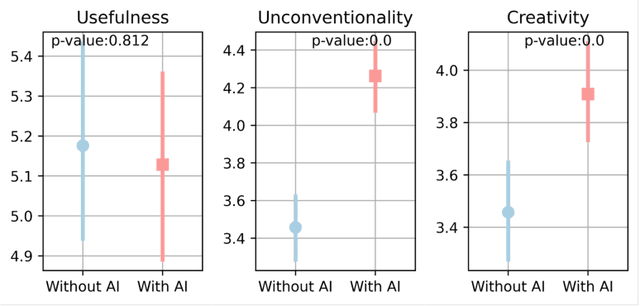
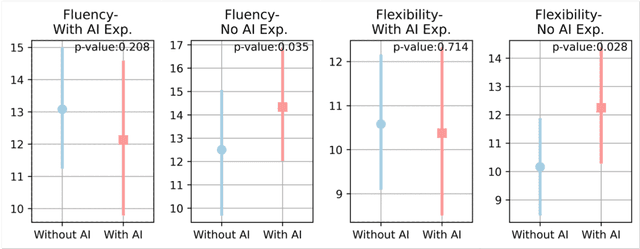
Abstract:As generative AI (GenAI) increasingly permeates design workflows, its impact on design outcomes and designers' creative capabilities warrants investigation. We conducted a within-subjects experiment where we asked participants to design advertisements both with and without GenAI support. Our results show that expert evaluators rated GenAI-supported designs as more creative and unconventional ("weird") despite no significant differences in visual appeal, brand alignment, or usefulness, which highlights the decoupling of novelty from usefulness-traditional dual components of creativity-in the context of GenAI usage. Moreover, while GenAI does not significantly enhance designers' overall creative thinking abilities, users were affected differently based on native language and prior AI exposure. Native English speakers experienced reduced relaxation when using AI, whereas designers new to GenAI exhibited gains in divergent thinking, such as idea fluency and flexibility. These findings underscore the variable impact of GenAI on different user groups, suggesting the potential for customized AI tools.
Should ChatGPT Write Your Breakup Text? Exploring the Role of AI in Relationship Dissolution
Jan 18, 2024

Abstract:Relationships are essential to our happiness and wellbeing. The dissolution of a relationship, the final stage of relationship's lifecycle and one of the most stressful events in an individual's life, can have profound and long-lasting impacts on people. With the breakup process increasingly facilitated by computer-mediated communication (CMC), and the likely future influence of AI-mediated communication (AIMC) tools, we conducted a semi-structured interview study with 21 participants. We aim to understand: 1) the current role of technology in the breakup process, 2) the needs and support individuals have during the process, and 3) how AI might address these needs. Our research shows that people have distinct needs at various stages of ending a relationship. Presently, technology is used for information gathering and community support, acting as a catalyst for breakups, enabling ghosting and blocking, and facilitating communication. Participants anticipate that AI could aid in sense-making of their relationship leading up to the breakup, act as a mediator, assist in crafting appropriate wording, tones, and language during breakup conversations, and support companionship, reflection, recovery, and growth after a breakup. Our findings also demonstrate an overlap between the breakup process and the Transtheoretical Model (TTM) of behavior change. Through the lens of TTM, we explore the potential support and affordances AI could offer in breakups, including its benefits and the necessary precautions regarding AI's role in this sensitive process.
MindShift: Leveraging Large Language Models for Mental-States-Based Problematic Smartphone Use Intervention
Sep 28, 2023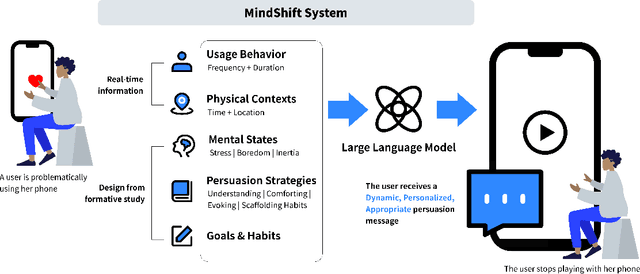

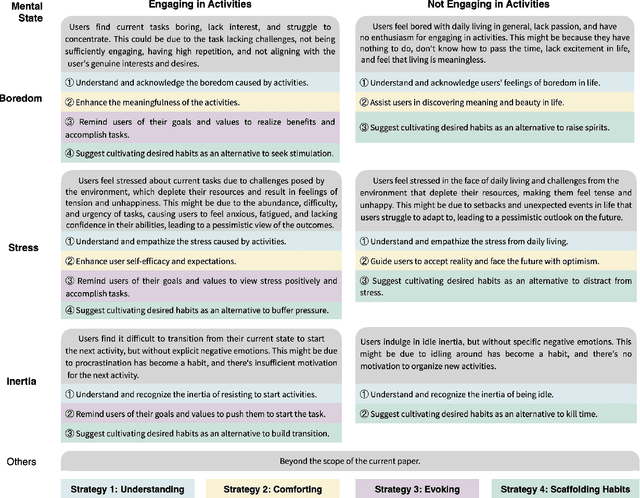
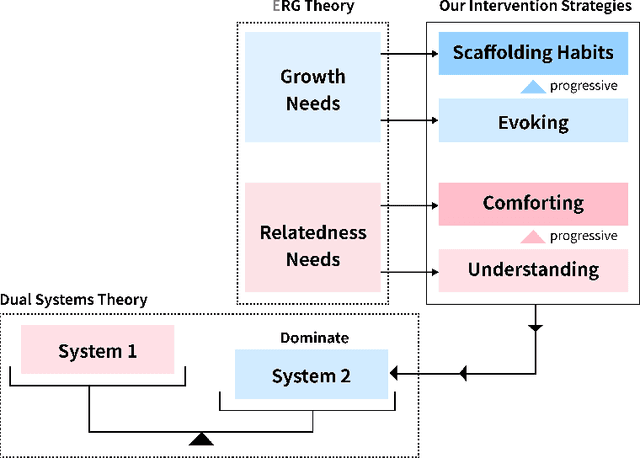
Abstract:Problematic smartphone use negatively affects physical and mental health. Despite the wide range of prior research, existing persuasive techniques are not flexible enough to provide dynamic persuasion content based on users' physical contexts and mental states. We first conduct a Wizard-of-Oz study (N=12) and an interview study (N=10) to summarize the mental states behind problematic smartphone use: boredom, stress, and inertia. This informs our design of four persuasion strategies: understanding, comforting, evoking, and scaffolding habits. We leverage large language models (LLMs) to enable the automatic and dynamic generation of effective persuasion content. We develop MindShift, a novel LLM-powered problematic smartphone use intervention technique. MindShift takes users' in-the-moment physical contexts, mental states, app usage behaviors, users' goals & habits as input, and generates high-quality and flexible persuasive content with appropriate persuasion strategies. We conduct a 5-week field experiment (N=25) to compare MindShift with baseline techniques. The results show that MindShift significantly improves intervention acceptance rates by 17.8-22.5% and reduces smartphone use frequency by 12.1-14.4%. Moreover, users have a significant drop in smartphone addiction scale scores and a rise in self-efficacy. Our study sheds light on the potential of leveraging LLMs for context-aware persuasion in other behavior change domains.
 Add to Chrome
Add to Chrome Add to Firefox
Add to Firefox Add to Edge
Add to Edge